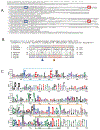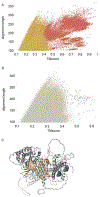Methods for discovering catalytic activities for pseudokinases
- PMID: 35525554
- PMCID: PMC9554938
- DOI: 10.1016/bs.mie.2022.03.047
Methods for discovering catalytic activities for pseudokinases
Abstract
Pseudoenzymes resemble active enzymes, but lack key catalytic residues believed to be required for activity. Many pseudoenzymes appear to be inactive in conventional enzyme assays. However, an alternative explanation for their apparent lack of activity is that pseudoenzymes are being assayed for the wrong reaction. We have discovered several new protein kinase-like families which have revealed how different binding orientations of adenosine triphosphate (ATP) and active site residue migration can generate a novel reaction from a common kinase scaffold. These results have exposed the catalytic versatility of the protein kinase fold and suggest that atypical kinases and pseudokinases should be analyzed for alternative transferase activities. In this chapter, we discuss a general approach for bioinformatically identifying divergent or atypical members of an enzyme superfamily, then present an experimental approach to characterize their catalytic activity.
Keywords: Atypical kinases; Bioinformatics; Pseudokinases; Uncharacterized proteins.
Copyright © 2022 Elsevier Inc. All rights reserved.
Figures





Similar articles
-
Genome-wide and structural analyses of pseudokinases encoded in the genome of Arabidopsis thaliana provide functional insights.Proteins. 2020 Dec;88(12):1620-1638. doi: 10.1002/prot.25981. Epub 2020 Aug 20. Proteins. 2020. PMID: 32667690
-
The expanding world of protein kinase-like families in bacteria: forty families and counting.Biochem Soc Trans. 2020 Aug 28;48(4):1337-1352. doi: 10.1042/BST20190712. Biochem Soc Trans. 2020. PMID: 32677675 Review.
-
Identifying pseudoenzymes using functional annotation: pitfalls of common practice.FEBS J. 2020 Oct;287(19):4128-4140. doi: 10.1111/febs.15142. Epub 2019 Dec 5. FEBS J. 2020. PMID: 31733177 Review.
-
Protein AMPylation by an Evolutionarily Conserved Pseudokinase.Cell. 2018 Oct 18;175(3):809-821.e19. doi: 10.1016/j.cell.2018.08.046. Epub 2018 Sep 27. Cell. 2018. PMID: 30270044 Free PMC article.
-
Tracing the origin and evolution of pseudokinases across the tree of life.Sci Signal. 2019 Apr 23;12(578):eaav3810. doi: 10.1126/scisignal.aav3810. Sci Signal. 2019. PMID: 31015289 Free PMC article.
Cited by
-
KINtaro: protein kinase-like database.BMC Res Notes. 2024 Feb 16;17(1):50. doi: 10.1186/s13104-024-06713-y. BMC Res Notes. 2024. PMID: 38365785 Free PMC article.
-
Biochemical and structural insights into a 5' to 3' RNA ligase reveal a potential role in tRNA ligation.bioRxiv [Preprint]. 2024 Apr 24:2024.04.24.590974. doi: 10.1101/2024.04.24.590974. bioRxiv. 2024. Update in: Proc Natl Acad Sci U S A. 2024 Oct 15;121(42):e2408249121. doi: 10.1073/pnas.2408249121. PMID: 38712170 Free PMC article. Updated. Preprint.
-
Biochemical and structural insights into a 5' to 3' RNA ligase reveal a potential role in tRNA ligation.Proc Natl Acad Sci U S A. 2024 Oct 15;121(42):e2408249121. doi: 10.1073/pnas.2408249121. Epub 2024 Oct 10. Proc Natl Acad Sci U S A. 2024. PMID: 39388274 Free PMC article.
-
Pan-kinome of Legionella expanded by a bioinformatics survey.Sci Rep. 2022 Dec 16;12(1):21782. doi: 10.1038/s41598-022-26109-x. Sci Rep. 2022. PMID: 36526881 Free PMC article.
References
Publication types
MeSH terms
Substances
Grants and funding
LinkOut - more resources
Full Text Sources
Molecular Biology Databases

